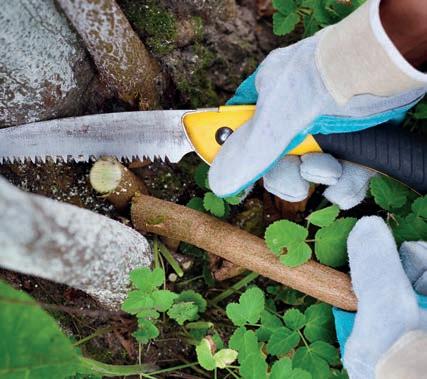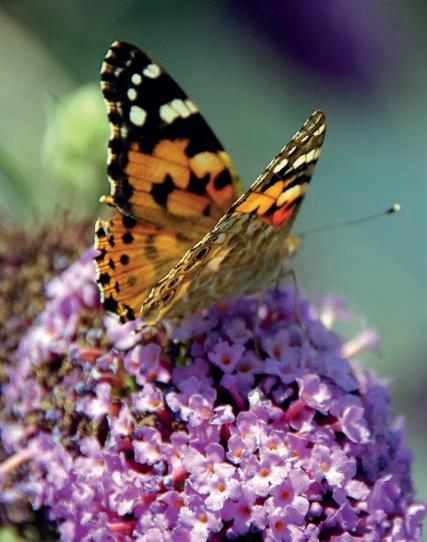
5 minute read
Dart Sailability moving home
Mr Fox’s Garden
In this issue Mr Fox decides to reprieve some mice he nds living in his greenhouse, gets to grips with homemade compost and muses over the unfortunate reputation of the lovely dandelion.
Advertisement

It’s that time of year again, tidy up time in the greenhouse, time to give the windows a good scrub with hot soapy water and get rid of all the algae. Our greenhouse becomes a dumping zone through the winter months, storing anything I need to keep dry and all the succulents too. I popped by to assess the job; it was one of those really cold mornings at the start of March. I detected a distinct smell in there. Mice, I thought to myself - poor little souls, they must be freezing out in this weather. I closed the door and walked away thinking they’ll have to go, but not today.
I found some clothes pegs I ordered on the internet last summer; they’d come direct from China, by air mail. One year later and they’ve already become brittle, cracked and broken. One thing’s for sure; the archaeologists of the future won’t be delicately brushing away the earth to reveal traces of us, there’ll be junk every where. We are in the ‘plastic age’. is year I’m really going to make an e ort in the greenhouse; I doubt I’ll grow Torbay’s biggest marrow but I’m going to try. I heard about ‘Just Eat’ the other day, the idea being you’re sitting there and you pick up your phone and order some food. en someone drives it over to you and you ‘just eat’. Sounds good but everyone knows that the best meals are home cooked and home grown. I’m planning on going one better this year; I’m doing home grown in my own homemade compost.
I’ve bought myself a fancy new compost bin, called a Hotbin. It was Product of the Year at the 2019 Chelsea Flower Show and I’ve wanted one ever since. £180 for a compost bin is a bit steep but I justi ed it by working out what I can save on buying compost from the shops. Wow it’s fantastic; all the garden waste and food waste goes in and before long it’s not waste any more. e Hotbin is literally eating it and it will soon be giving us back ne rich compost (in 50 days). I’ll let you know what it’s like when I get the nal product but even before it’s produced anything, the Hotbin is de nitely the highlight of my year and my new favourite member of the family. So maybe preparing a good meal should begin a year in advance when you’re mixing the compost in which you’ll be planting your food. If anyone in Torquay manages to grow any giant veg please send me a picture, I’d love to see it. My email is James.a.fox@outlook.com
A few years ago when saving bees was becoming popular. I was declaiming ‘Save the Dandelions!’ Dandelions are just as good a pollinator as any ower but what kind of gardener can make a living whilst not wanting to pull out dandelions out? I still claim dandelions are lovely little plants; if they were di cult to grow everyone would want them...
Enjoy Spring! Mr Fox
We are James and Catherine (Mr Fox’s Garden). We provide a garden maintenance and landscaping service around the Bay but the main part of our business is making plant supports, garden art and sculptures - and it’s all made right here on the English Riviera. After our display garden won the People’s Choice Award at the 2019 Tavistock Garden Show, we can now happily say we are ‘award winning gardeners’. We’re also proud to say that this year we have pieces on permanent display at RHS Rosemoor and Buckfast Abbey. Mr Fox






Early spring is a great time to revitalise and replan garden borders. New plants can be settled in before the growing season really kicks o ; prune mature shrubs hard to reinvigorate and encourage new healthy growth; herbaceous perennials and ornamental grasses can be divided to turn single plants or small groups into large, eyecatching spreads. A variety of approaches will be needed when renovating borders. Start by looking at the largest plants – usually shrubs. Even quite mature plants, particularly evergreens,

can be moved to a new site if done with care. It very much depends on the type and the root system, but if a plant is in the wrong place, it’s worth a go. Make sure to check for nesting birds rst. Get the new planting hole prepared rst then dig round the plant and slip a piece of tarp underneath to keep as much soil round the roots as possible. The other option is to hard prune - the usual method of rejuvenating a mature plant is to thin out about a third of the oldest stems near the ground, letting light and air through the congested centre and encouraging new growth. However, there are some shrubs such as camellias and laurels that can be taken back almost to the
Hard Pruning - thin out about a third of the oldest stems near the ground ground, even when mature, and which will regrow really well. Also late-summer owering shrubs such as butter y bush (Buddleja) can be hard pruned in total too. Introducing just a few new plants to a border can make a wonderful transformation. Think about contrasting shape, foliage, and stem colour, as these will impact all year. Flowers are delightful, of course, and choosing blooms for a succession of colour through every season will pay dividends. Choose pollinator-friendly plants wherever possible; bees, butter ies and other insects need every bit of help we can give.
Seasonal jobs for April
- Plant lily bulbs in tubs or in the ground, into well drained soil or compost. - Big clumps of crocus and snowdrops can be transplanted now by lifting the clump, separating into several clusters of bulbs, and replanting for next year. - Save a lot of hard work later by keeping on top of those weed seedlings. Whizz round with a hoe on a dry day to slice o young weeds. - Instead of weedkiller, kill weeds the slow and easy way, by covering the ground with light-excluding brown cardboard or landscaping fabric. - Plant seed potatoes, onion sets, shallot, and garlic varieties that are suitable for spring planting.












